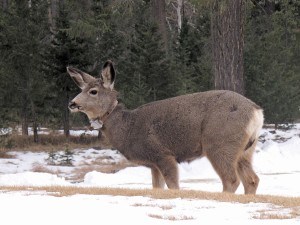
As media outlets from around the world pounced on a story about poachers using technology to locate tagged animals earlier this month, another theme emerged: you don’t have to be armed to adversely affect an animal.
In fact, in many cases it turns out to be people who would consider themselves outdoor enthusiasts or even conservationists who are doing the most damage.
Dr. Steven Cooke, a biologist at Ottawa’s Carleton University, was unexpectedly thrust into the limelight after a notice he wrote to his colleagues in the science community went viral.
Cooke expressed concern that the worlds of poaching and hacking had collided with devastating effect endangering species being monitored by scientists. According to his research, ill-intentioned hunters around the world were using the signals from radio collars on animals like endangered rhinos to find and harvest them.
He suggested hunters were also hacking scientific databases to mine data helpful to their cause.
“You usually think about this in terms of national security or personal health,” Cooke said. “But data, as an ecologist, on the surface is not something that seems like it should be protected under three levels of encryption.”
Cooke is one of the many biologists who work primarily with fish; with more than 100,000 currently tagged in the Columbia Valley River system alone, there are more fish marked by scientists every year than any other species.
A tagged pike may not be particularly valuable, nor an entire school, given the chancey nature of angling, but humans, including scientists, that use technology to study animals can impact wildlife behaviour despite even their best intentions.
The word of the day according to Dr. Adam Ford is “non-consumptive effect.”
Based at the University of British Columbia Okanagan (UBCO), Ford has done work on human-wildlife conflict in places as disparate as Africa and Canmore.
“Poaching invokes the idea of people killing wildlife illegally and that’s serious, but the more nuanced side is we can inadvertently affect animal movements,” he said. “Animals can become overexposed to interactions with people, which can lead to a lack of fear of people.”
He said some species that have been “off the radar” in terms of human conflict are suddenly becoming problematic, pointing to recent interactions with wolves.
“I wouldn’t say the rogue tracking folks are the entire cause of habituation, but it doesn’t help,” Ford continued. “A predator can have a non-consumptive effect on prey by scaring it and changing its behaviour. This is almost the same thing and it’s why Parks (Canada) was wise to take action to prevent it.”
Parks Canada banned VHF receivers in the three mountain parks in 2016, but not in JNP.
“Parks has been dealing with this for some time in the Pacific Rim, a lot of good work was done on this about 10 years ago,” he continued. “It turned out some of the most educated people visiting the park were the biggest problem. It was driven by the powerful emotional experience of exposure to animals.”
Bill Abercrombie, vice president of the Alberta Trappers Association, is no stranger to such a sensation. He told the 51���� his members would be the last people who would be found out in the field with illegal antennae.
“Our goal to keep the land wild and keep the animals wild,” he said. “If we can’t do that (in the parks), it will be harder to do it elsewhere outside the park where the mandate for conservation isn’t as strong.”
Abercrombie said his members work with scientists to make their research more effective, pointing to a partnership with the University of Alberta to study the elusive wolverine.
“I think the potential for that kind of abuse is less here; it’s not like you’re cruising over the serengeti in a Land Rover,” he said. “Even if you ‘locate’ a grizzly out here, you still have to find it in pretty rugged terrain.
“We would be the last people to engage in some sort of illegitimate activity like that. Frankly, if we found people engaging in that, we would put a stop to it.”
Craig Gilbert
[email protected]
